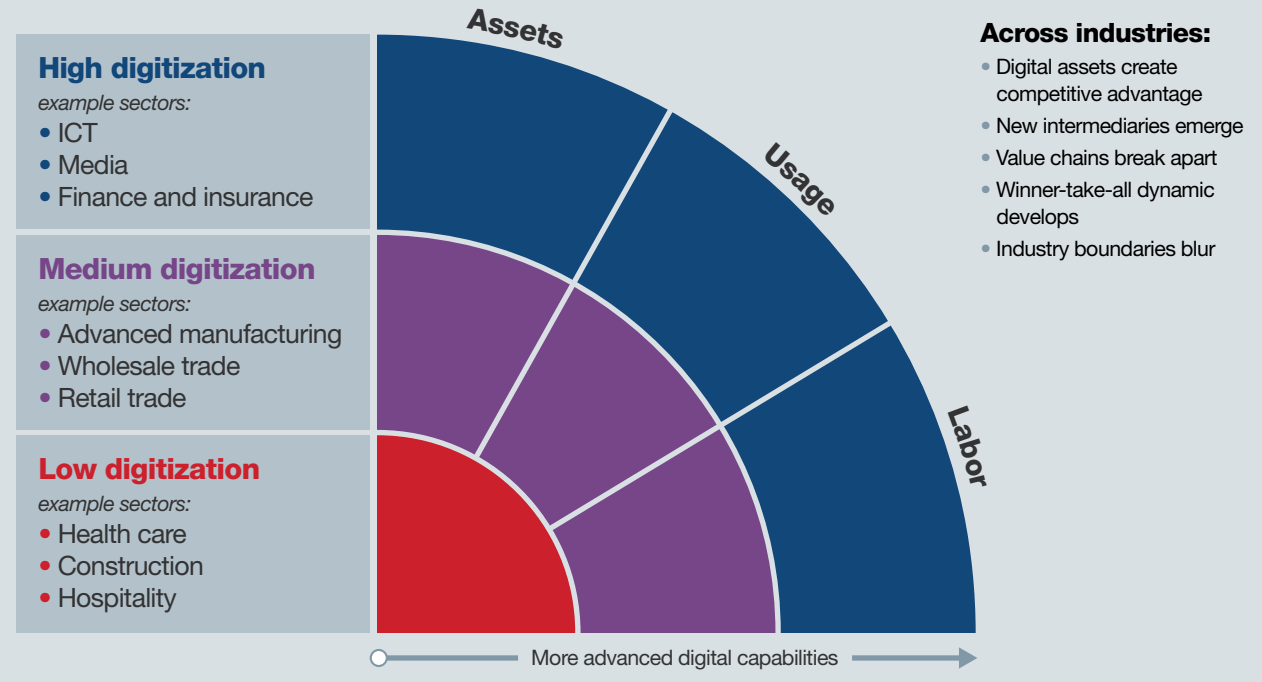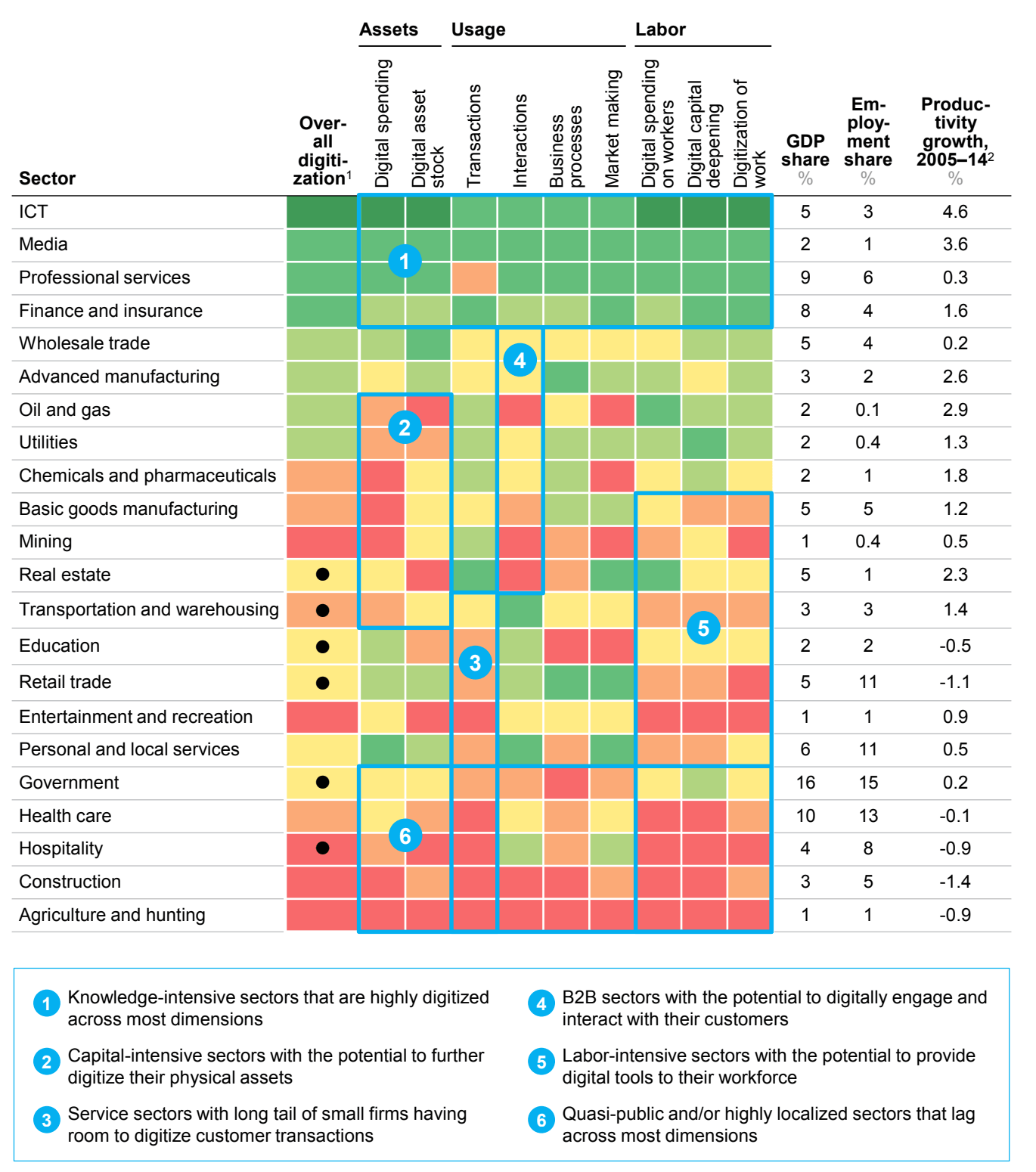Many people have asked why we started to build Assignar, which solves a number of complex problems in the construction industry and many other industries that haven’t been able to adopt technology in recent years.
The world is digitising so rapidly that most users are scrambling to adapt. The race to keep up with technology and put it to the most effective business use is producing digital “haves” and “have-mores” — and the large, persistent gap between them is becoming a decisive factor in competition across the economy.
- Digitisation is happening unevenly, and users with advanced digital capabilities are capturing disproportionate benefits. The companies leading the charge are winning the battle for market share and profit growth; some are reshaping entire industries to their own advantage. But many businesses are struggling to evolve quickly enough. Workers in the most digitised industries enjoy wage growth that is twice the national average, while the majority of workers face stagnant incomes and uncertain prospects.
- Digitisation is not just about buying IT equipment and systems. The most explosive growth is now in usage as companies continue to integrate digital tools into an ever-widening variety of business processes. MGI’s Industry Digitisation Index is the first major effort to capture how this activity is playing out at the sector level. It compiles dozens of indicators to provide a picture of digital assets, usage, and workers across the economy. In addition to the information and communications technology (ICT) sector, media, financial services, and professional services are surging ahead, while others have significant upside to capture. In fact, most sectors across the economy are less than 15 percent as digitised as the leading sectors. Despite a great rush of adoption, this gap has barely narrowed over the past decade. We see this pattern at the company level as well as the sector level.
- Digitisation is changing the dynamics in many industries. New markets are proliferating, value chains are breaking up, and profit pools are shifting. Businesses that rely too heavily on a single revenue stream or on playing an intermediary role in a given market are particularly vulnerable. In some markets, there is a winnertake-all effect. For companies, this is a wake-up call—and an opportunity to reinvent every process with a fresh focus on the customer
- As digitisation accelerates, the United States has a major opportunity to boost productivity growth. Looking at just three big areas of potential—online talent platforms, big data analytics, and the Internet of Things— we estimate that digitisation could add up to $2.2 trillion to annual GDP by 2025, although the possibilities are much wider. Some of the sectors that are currently lagging could be poised for rapid growth. Companies in manufacturing, energy, and other heavy industries are investing in digitising their extensive physical assets, bringing us closer to the era of connected cars, smart buildings, and intelligent oil fields.
- But there will also be more economic dislocation. As digital technologies automate many of the tasks that humans are paid to do, the day-to-day nature of work will change in a majority of occupations. As companies redefine many roles and business processes, workers of all skill levels will be affected. Historical job displacement rates could accelerate sharply over the next decade. Australia and the world will need to adapt its institutions and training pathways to help workers acquire relevant skills and navigate this period of transition and churn.
Today the race is on to capture value from data analytics and the Internet of Things, but there is no finish line. Digitisation involves continuously experimenting and adapting, whether the focus is on back-office processes, the customer experience, or the introduction of new products and services. It takes investment, agility, and relentless focus to stay ahead in this hyper-competitive new world, but there are outsized opportunities for the organisations and individuals that can establish themselves as digital leaders.
The image below illustrates MGI’s Industry DigitiSation Index which combines 27 indicators to measure the digital assets,
digital usage, and digital workers in each sector.

Digital innovation, adoption, and usage are evolving at a supercharged pace across the Australian and US economies. As successive waves of innovation expand the definition of what is possible, the most sophisticated users have pulled far ahead of everyone else in the race to keep up with technology and devise the most effective business uses for it. Construction unfortunately, is one of the least digitised industries on the planet.

Assignar Hypothesis
After almost 18 months of building Assignar, digitising our industry and gaining valuable feedback from our customers, we have identified a gap in the following areas that still need to be addressed:
- Invoicing
- Pay rates
- Charge rates
- Smart forms
- Compliance rules
- Fatigue management
While we have been tackling each of those items separately, further developments are required based on our initial findings. Some of those findings are, but not limited to:
- Invoices are incomplete since they are often required to be integrated with 3rd party invoicing platforms, such as Xero, SAP, MYOB, Interdynamics, Unit4, Sage, which consist of different data models. We need to come up with a flexible solution that allows our customers to customise the output of their Assignar line items so that they can be effortlessly integrated into their accounting platforms of their choice. At the time of writing, there is nothing on the market that can achieve this goal and we have been hard at work, trying to innovate and build something that solves this problem.
- Incorrect pay rates. Applying correct pay rates requires a great deal of detail in a sense that they can be applied to a variety of levels, such as: Client, Project, Asset, Worker, Task, Supplier just to name a few. There is no “off the shelf” solution here and Assignar team are working hard to solve this challenging problem. Pay rates are hourly units that are used to calculate correct payments to be made to employees.
- Incorrect charge rates. The challenges with charge rates are identical to the ones with pay rates. Charge rates are hourly units that Assignar customers include in their invoices as line items.
- Smart forms need to scale. Assignar Smart forms have been an absolute hit with our customers and there is nothing similar on the market that solves digital data capture from the filed the way Assignar Smart Forms solve it. However, with fast adoption we running with a scale challenge in a sense that each question response is stored as a unique row in the database.
- Compliance Rules needed to be more granular and flexible. Regulated industries are compliance driven and Assignar must have an ability to apply Skill, Competency and Induction requirements against many different levels. Those rules are very similar to pay rates and charge rates mentioned above. Compliance rules must be flexible enough so that they can be applied to many levels, such as Clients, Projects, Tasks and Assets. There are many scheduling tools out there as well as compliance tools. However, there is nothing on the market that combines the two problems together into a single solution. This is what Assignar team are working hard on implementing and offering to customers.
- Fatigue management is a big problem in heavily regulated industries. Assignar tries to tackle this problem by increasing visibility into field operations and capturing of data in digital format in real-time so that better decisions can be made. Managing fatigue in a more optimal way is the key to better fatigue management. However, Assignar’s fatigue management, at the time of writing, focuses on lagging indicators. More work needs to be done to provide leading indicators into worker fatigue. Integration with FAID Quantum Software is needed to add some level of sophistication to Assignar’s fatigue management solution.


